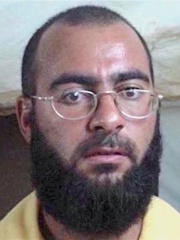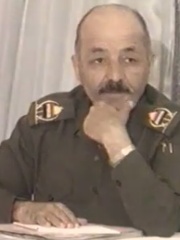


The Most Famous
EXTREMISTS from Iraq
This page contains a list of the greatest Iraqi Extremists. The pantheon dataset contains 283 Extremists, 3 of which were born in Iraq. This makes Iraq the birth place of the 20th most number of Extremists behind Iran, and Ukraine.
Top 3
The following people are considered by Pantheon to be the most legendary Iraqi Extremists of all time. This list of famous Iraqi Extremists is sorted by HPI (Historical Popularity Index), a metric that aggregates information on a biography's online popularity.

1. Abu Bakr al-Baghdadi (1971 - 2019)
With an HPI of 73.04, Abu Bakr al-Baghdadi is the most famous Iraqi Extremist. His biography has been translated into 85 different languages on wikipedia.
Ibrahim Awwad Ibrahim Ali al-Badri (28 July 1971 – 27 October 2019), commonly known by his nom de guerre Abu Bakr al-Baghdadi, was an Iraqi militant leader and former teacher who was the founder and first leader of the Islamic State (IS), who proclaimed himself caliph in 2014 and stayed in power until his suicide in an American operation in 2019. Baghdadi was born in Samarra and obtained graduate degrees in Islamic theology in the late 1990s and 2000s. According to supporters, he obtained a PhD at the Islamic University of Baghdad. Following the American invasion of Iraq in March 2003, Baghdadi led the "Jama'at Jaysh Ahl al-Sunna wal-Jama'ah" insurgent group in Iraq and was detained with al-Qaeda commanders at the American Camp Bucca in 2004. His group joined the Mujahideen Shura Council (MSC) coalition in 2006 and fought alongside al-Qaeda in Iraq. Upon the dissolution of the MSC in October 2006, Baghdadi became a leading member of the newly established Islamic State of Iraq organization, and rose through the group's ranks until he was appointed its emir, the highest leader, in 2010. In March 2013, the group renamed itself as the "Islamic State of Iraq and Levant" (ISIL), announcing its intention to expand into Syria and forcibly assimilate the Al-Nusra Front, leading to a conflict with al-Qaeda's general command. In June 2014, the group once again re-designated itself as the "Islamic State", and declared itself to be a caliphate. Baghdadi was chosen caliph of the Islamic State by a "Shura Council", which represented those members of the Islamic State allegedly qualified to elect a caliph. IS was designated as a terrorist organisation by the United Nations and almost all sovereign states, and Baghdadi was individually considered a terrorist by the United States and many other countries. As leader of IS, Baghdadi led the Islamic State's wars against Iraq and Syria. Baghdadi directed the use of tactics including the mass use of suicide bombings and the execution of prisoners of war. IS briefly captured substantial territory in Iraq and Syria, but lost all of that territory and almost all of its fighters during Baghdadi's tenure as caliph. Baghdadi would become directly involved in IS's atrocities and human rights violations. These include the genocide of Yazidis in Iraq, extensive sexual slavery, organized rape, floggings, and systematic executions. He directed terrorist activities and massacres. He embraced brutality as part of the organization's propaganda efforts, producing videos displaying sexual slavery and executions via hacking, stoning and burning. Baghdadi himself kept several personal sex slaves. On 27 October 2019, Baghdadi killed himself and two children by detonating a suicide vest during the Barisha raid, conducted by the United States following approval from President Donald Trump, in Syria's northwestern Idlib Province. After being offered Islamic funeral rites, his body was buried at sea. IS confirmed his death and named Abu Ibrahim al-Hashimi al-Qurashi as his replacement.

2. Taha Yassin Ramadan (1938 - 2007)
With an HPI of 66.28, Taha Yassin Ramadan is the 2nd most famous Iraqi Extremist. His biography has been translated into 22 different languages.
Taha Yassin Ramadan al-Jazrawi (Arabic: طه ياسين رمضان الجزراوي; 20 February 1938 – 20 March 2007) was an Iraqi military officer and politician who served as the vice president of Iraq from March 1991 to the fall of Saddam Hussein in April 2003 and the commander of the Popular Army. He is often referred to as "the difficult man" and "the man of major missions." Known for his serious demeanor and deep knowledge of Iraqi-Soviet relations, he has played a significant role in Iraq's leadership.

3. Abu Ibrahim al-Hashimi al-Qurashi (1976 - 2022)
With an HPI of 61.34, Abu Ibrahim al-Hashimi al-Qurashi is the 3rd most famous Iraqi Extremist. His biography has been translated into 36 different languages.
Abu Ibrahim al-Hashimi al-Qurashi (Arabic: أبو إبراهيم الهاشمي القرشي, romanized: Abū Ibrāhīm al-Hāshimī al-Qurashī; born Amir Mohammed Abdul Rahman al-Mawli al-Salbi (Arabic: أمير محمد عبد الرحمن المولى الصلبي, romanized: Amīr Muḥammad ʿAbd al-Raḥmān al-Mawlā al-Ṣalibi); 1 or 5 October 1976 – 3 February 2022) was an Iraqi militant and the second caliph of the Islamic State from 2019 until his suicide in 2022. His appointment by a shura council was announced by the Islamic State media on 31 October 2019, less than a week after the death of the previous caliph Abu Bakr al-Baghdadi. Al-Qurashi's tenure as caliph saw the Islamic State being mostly limited to insurgent activity in the Middle East, but also make substantial advances in Africa, where IS increased its territories and influence. The U.S. Rewards for Justice Program was offering up to $10 million in exchange for information leading to al-Qurashi's apprehension. On 3 February 2022, al-Qurashi killed himself, and members of his family, by triggering a large bomb during a raid by the U.S. Joint Special Operations Command.
People
Pantheon has 3 people classified as Iraqi extremists born between 1938 and 1976. Of these 3, none of them are still alive today. The most famous deceased Iraqi extremists include Abu Bakr al-Baghdadi, Taha Yassin Ramadan, and Abu Ibrahim al-Hashimi al-Qurashi.
Deceased Iraqi Extremists
Go to all RankingsAbu Bakr al-Baghdadi
1971 - 2019
HPI: 73.04
Taha Yassin Ramadan
1938 - 2007
HPI: 66.28
Abu Ibrahim al-Hashimi al-Qurashi
1976 - 2022
HPI: 61.34
Overlapping Lives
Which Extremists were alive at the same time? This visualization shows the lifespans of the 3 most globally memorable Extremists since 1700.

